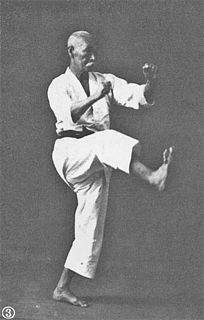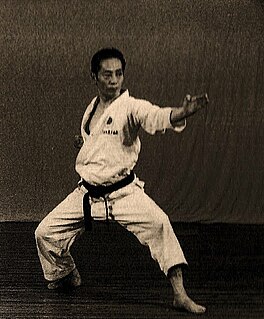
Karate (空手) is a martial art developed in the Ryukyu Kingdom. It developed from the indigenous Ryukyuan martial arts under the influence of Kung Fu, particularly Fujian White Crane. Karate is now predominantly a striking art using punching, kicking, knee strikes, elbow strikes and open-hand techniques such as knife-hands, spear-hands and palm-heel strikes. Historically, and in some modern styles, grappling, throws, joint locks, restraints and vital-point strikes are also taught. A karate practitioner is called a karateka (空手家).
Keigo Abe was a prominent Japanese master of Shotokan karate who founded the Japan Shotokan Karate Association in 1999 and is its Chief Instructor. He holds the rank of 9th dan in karate, is a direct student of Masatoshi Nakayama (1913–1987), and was a senior instructor in the Japan Karate Association.
Japan Karate Association is one of the most influential Shotokan karate organizations in the world. It is also one of the oldest karate organizations continuously in operation until the present.
Randall G. Hassell was the Chief Instructor for the American Shotokan Karate Alliance (ASKA), Senior Editor of Tamashii Press, President of the American JKA Karate Association (AJKA), and a Founding Fellow of the International Karate Society (IKS).
The World Karate Federation (WKF) is the largest international governing body of sport karate with 198 member countries. It was formed in 1990, is the only karate organization recognised by the International Olympic Committee and has more than ten million members. The WKF organizes the Junior and Senior Karate World Championships, which are each held every other year. The President of the WKF is Antonio Espinos, and the headquarters are located in Madrid, Spain. The styles recognised by the WKF are Gōjū-ryū, Shitō-ryū, Shotokan and Wadō-ryū.

Tsutomu Ohshima is a prominent Japanese master of Shotokan karate who founded the organization Shotokan Karate of America (SKA). He is the Shihan of the SKA, and to this day holds the rank of 5th dan, which was awarded to him by Gichin Funakoshi. Ohshima’s branch of the Shotokan world has become known as “Shotokan Ohshima Karate-do.”

Tetsuhiko Asai was a prominent Japanese master of Shotokan karate of the Japan Karate Association (JKA), founder and Chief Instructor of the International Japan Martial Arts Karate Asai-ryu (IJKA), and founder of the Japan Karate Shoto Federation.

Teruyuki Okazaki, was a tenth degree black belt in Shotokan Karate, as well as the founder and chief instructor of the International Shotokan Karate Federation (ISKF). Along with Gichin Funakoshi and Masatoshi Nakayama, Okazaki helped found the Japan Karate Association's instructor training program.

Takayuki Mikami is a Japanese master of Shotokan karate based in the United States of America. He holds the rank of 9th dan black belt in the art, awarded under the Japan Karate Association. In 1958, Mikami tied for first place in the All Japan Karate Championships. The following year, he became the All Japan champion in kumite (sparring) as well as kata (patterns). In 1961, Mikami won first place in kata again. He was also the first person to graduate from the Japan Karate Association's (JKA) instructor training program instituted by Gichin Funakoshi and Masatoshi Nakayama.

Hidetaka Nishiyama was a prominent Japanese master of Shotokan karate. He was an internationally recognized instructor, author, and administrator, and helped to establish the Japan Karate Association. Nishiyama was one of the last surviving students of Gichin Funakoshi, founder of Shotokan karate. He was based in the United States of America from 1961 until his death in 2008, and was a pioneer of karate in that country. He had been posthumously awarded the rank of 10th dan in karate.

Yutaka Yaguchi is the Chief Instructor and Chairman of the International Shotokan Karate Federation (ISKF) Mountain States Region. He was born in Hiroshima, Japan, in 1932 and began karate training in 1952. He later tested under masters Gichin Funakoshi for his 1st dan black belt and Masatoshi Nakayama for his 2nd through 8th dan black belts. As one of the first graduates of the Japan Karate Association (JKA) Instructors' Training Program in 1959, he has played an important role in the growth of JKA karate and the internationalization of Shotokan karate. Yaguchi first arrived in the United States on June 5, 1965, and continues to reside in the US to the present day. In 1974, Yaguchi founded the ISKF of Colorado, the regional headquarters for the Mountain States Region.

Kenkojuku is a style of Shotokan karate previous to the establishment of the Japan Karate Association (JKA) style. It was founded by Tomosaburo Okano. Kenkojuku karate is similar to the teachings of Gichin Funakoshi and modifications made by Funakoshi´s son Yoshitaka Funakoshi. JKA Shotokan differs slightly in that it was Masatoshi Nakayama's version of Shotokan. Okano's/Yoshitaka's Kenkojuku karate and JKA karate are becoming more similar compared to other variants of Shotokan karate such as Shigeru Egami's Shotokai, Hirokazu Kanazawa's Shotokan Karate International or SKI.

Keinosuke Enoeda was a Japanese master of Shotokan karate. He was a former Chief Instructor of the Karate Union of Great Britain. Enoeda was ranked 8th dan in Shotokan karate, and was widely renowned as a formidable karateka. Following his death, Enoeda was posthumously awarded the rank of 9th dan.
Isao Obata was a pioneering Japanese master of Shotokan karate. He was a senior student of Gichin Funakoshi, who is widely recognized as the founder of modern karate, and was a key figure in the establishment of the Japan Karate Association (JKA) under Funakoshi in 1949. Obata also helped introduce karate to the United States of America through his demonstrations of the art to United States Air Force personnel, and through his students, most notably Tsutomu Ohshima.
Japan Shotokan Karate Association (JSKA) is one of the fastest growing Shotokan Karate associations in the world, founded by Keigo Abe in 1999. Abe was a former instructor graduate of the Japan Karate Association and trained and taught at the JKA Headquarters for nearly 35 years. He held a number of senior positions within the JKA and latterly the Matsuno section of the JKA. He had been a senior student of Nakayama and as such the teachings of Nakayama remain an integral part of the evolution of the Shotokan style within the JSKA. Abe Sensei died on the 20th of December 2019.
Yoshiharu Osaka is a Japanese instructor of Shotokan karate. He has won the JKA's version of the world championships for kata on four occasions. He has also won the JKA All-Japan championships for kata on six occasions and for kumite on two occasions.
Minoru Kawawada is a Japanese master of Shotokan karate. He has won the JKA's version of the world championships for both kata and kumite, and has also won the JKA All-Japan Championships for kata on 2 occasions. He is currently the Vice General Manager of the Japan Karate Association Technical Division, and an instructor at their headquarters dojo, as well as the famous Hoitsugan dojo founded by Masatoshi Nakayama.

Katsutoshi Shiina is a Japanese master of Shotokan karate. He has won the JKA's version of the world championships for kata. He has also won the JKA All-Japan championships for kata on 2 occasions and for kumite on 3 occasions. He is currently an instructor of the Japan Karate Association.
Stan Schmidt was a South African master of Shotokan karate. Along with others, such as Norman Robinson, he was an early practitioner of Shotokan karate in South Africa and his establishment of the South African branch of the Japan Karate Association (JKA) in 1965 after training in Japan, along with his subsequent promotion of the art in South Africa, earned him the appellation of 'The Father of South African Karate'. In 1963, he was one of the first westerners to be invited into the JKA's famous Instructor Class in the Tokyo Honbu dojo and he was later one of four non-Japanese karateka to sit on the JKA's international Shihankai. He was also the first non-Japanese karateka to attain 7th dan from the JKA and also the first to attain 8th dan. Today, he is the highest ranking non-Japanese karate master of that organization. He is also known for his acting roles in several martial arts films of the 1970s and 1980s.









